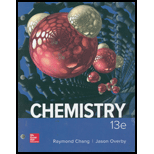
The following are two reaction schemes involving magnesium. Scheme I: When magnesium burns in oxygen, a white solid (A) is formed. A dissolves in 1 M HCl to give a colorless solution (B). Upon addition of Na2CO3 to B, a white precipitate is formed (C). On heating, C decomposes to D and a colorless gas is generated (E). When E is passed through limewater [an aqueous suspension of Ca(OH)2], a white precipitate appears (F). Scheme II: Magnesium reacts with 1 M H2SO4 to produce a colorless solution (G). Treating G with an excess of NaOH produces a white precipitate (H). H dissolves in 1 M HNO3 to form a colorless solution. When the solution is slowly evaporated, a white solid (I) appears. On heating I, a brown gas is given off. Identify A-I and write equations representing the reactions involved.
Interpretation:
The equations representing A-I involved reactions has to be written.
Concept introduction:
- To write a chemical reaction from the given information we must understand which is going to react and which is going to form as product in a particular chemical reaction.
- First write down the reactants in left side and analyze carefully the possibility of product obtained and this has to be placed in right side of a reaction.
- We can represent a reaction by writing reactants in left side and products in the right side.
Explanation of Solution
To identify A in the reaction of
2 moles of magnesium reacts with 1 mole of oxygen to produce 2 moles of magnesium oxide in solid form and the reaction scheme has to be represented as follows
A=
To identify B in the reaction of
1 mole of magnesium oxide reacts with 2 moles of hydrogen chloride to produce 1 mole of magnesium chloride in aqueous form and the reaction scheme has to be represented as follows
B=
To identify C in the reaction of
1 mole of magnesium chloride reacts with 1 mole of sodium carbonate to produce 1 mole of magnesium carbonate in solid form and 2 moles of sodium chloride and the reaction scheme has to be represented as follows
C=
To identify D in the reaction of
On heating, magnesium carbonate decomposed into magnesium oxide and carbon dioxide and the reaction has to be represented as follows
D =
To identify F in the reaction of
Carbon dioxide reacts with calcium hydroxide to produce calcium carbonate and water and the reaction has to be represented as follows
F =
To identify G in the reaction of
Magnesium reacts with sulfuric acid to produce magnesium sulfate and hydrogen gas and the reaction is represented as follows
G =
To identify H in the reaction of
Magnesium sulfate reacts with sodium hydroxide to produce magnesium hydroxide and sodium sulfate and the reaction has to be represented as follows
H=
To identify I in the reaction of
Magnesium hydroxide reacts with nitric acid to produce magnesium nitrate and water after evaporation and the reaction is represented as follows
I =
And
Want to see more full solutions like this?
Chapter 21 Solutions
CHEMISTRY (LOOSELEAF) >CUSTOM<
- The amount of sodium hypochlorite in a bleach solution can be determined by using a given volume of bleach to oxidize excess iodide ion to iodine; ClO- is reduced to Cl-. The amount of iodine produced by the redox reaction is determined by titration with sodium thiosulfate, Na2S2O3; I2 is reduced to I-. The sodium thiosulfate is oxidized to sodium tetrathionate, Na2S4O6. In this analysis, potassium iodide was added in excess to 5.00 mL of bleach (d=1.00g/cm3) . If 25.00 mL of 0.0700 M Na2S2O3 was required to reduce all the iodine produced by the bleach back to iodide, what is the mass percent of NaClO in the bleach?arrow_forwardWhich is the stronger acid, H2SO4 or H2SeO4? Why? You may wish to review the Chapter on acid-base equilibria.arrow_forward
 Chemistry: Principles and ReactionsChemistryISBN:9781305079373Author:William L. Masterton, Cecile N. HurleyPublisher:Cengage Learning
Chemistry: Principles and ReactionsChemistryISBN:9781305079373Author:William L. Masterton, Cecile N. HurleyPublisher:Cengage Learning General Chemistry - Standalone book (MindTap Cour...ChemistryISBN:9781305580343Author:Steven D. Gammon, Ebbing, Darrell Ebbing, Steven D., Darrell; Gammon, Darrell Ebbing; Steven D. Gammon, Darrell D.; Gammon, Ebbing; Steven D. Gammon; DarrellPublisher:Cengage Learning
General Chemistry - Standalone book (MindTap Cour...ChemistryISBN:9781305580343Author:Steven D. Gammon, Ebbing, Darrell Ebbing, Steven D., Darrell; Gammon, Darrell Ebbing; Steven D. Gammon, Darrell D.; Gammon, Ebbing; Steven D. Gammon; DarrellPublisher:Cengage Learning Chemistry & Chemical ReactivityChemistryISBN:9781337399074Author:John C. Kotz, Paul M. Treichel, John Townsend, David TreichelPublisher:Cengage Learning
Chemistry & Chemical ReactivityChemistryISBN:9781337399074Author:John C. Kotz, Paul M. Treichel, John Townsend, David TreichelPublisher:Cengage Learning Chemistry & Chemical ReactivityChemistryISBN:9781133949640Author:John C. Kotz, Paul M. Treichel, John Townsend, David TreichelPublisher:Cengage Learning
Chemistry & Chemical ReactivityChemistryISBN:9781133949640Author:John C. Kotz, Paul M. Treichel, John Townsend, David TreichelPublisher:Cengage Learning Chemistry: Principles and PracticeChemistryISBN:9780534420123Author:Daniel L. Reger, Scott R. Goode, David W. Ball, Edward MercerPublisher:Cengage Learning
Chemistry: Principles and PracticeChemistryISBN:9780534420123Author:Daniel L. Reger, Scott R. Goode, David W. Ball, Edward MercerPublisher:Cengage Learning Chemistry by OpenStax (2015-05-04)ChemistryISBN:9781938168390Author:Klaus Theopold, Richard H Langley, Paul Flowers, William R. Robinson, Mark BlaserPublisher:OpenStax
Chemistry by OpenStax (2015-05-04)ChemistryISBN:9781938168390Author:Klaus Theopold, Richard H Langley, Paul Flowers, William R. Robinson, Mark BlaserPublisher:OpenStax





